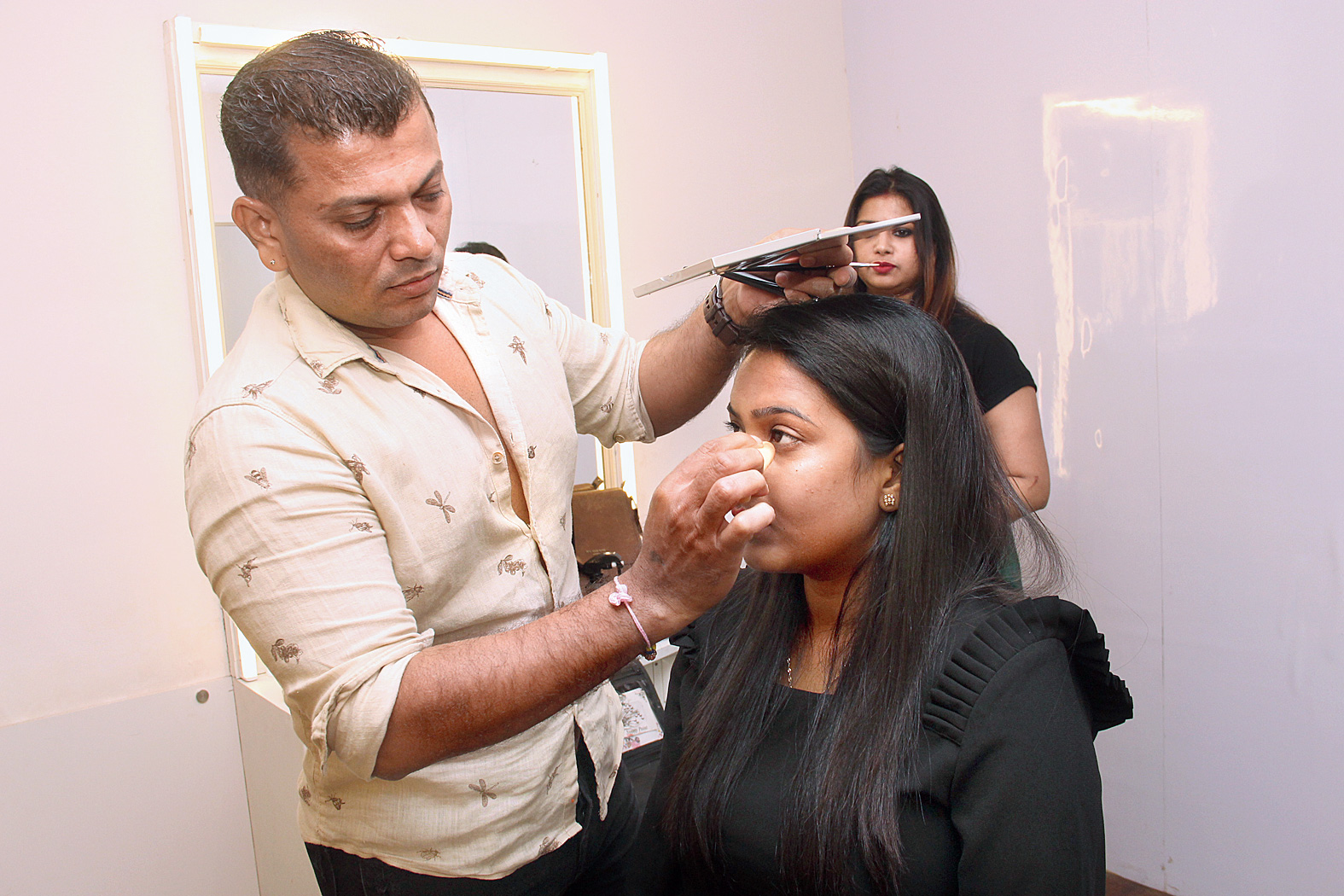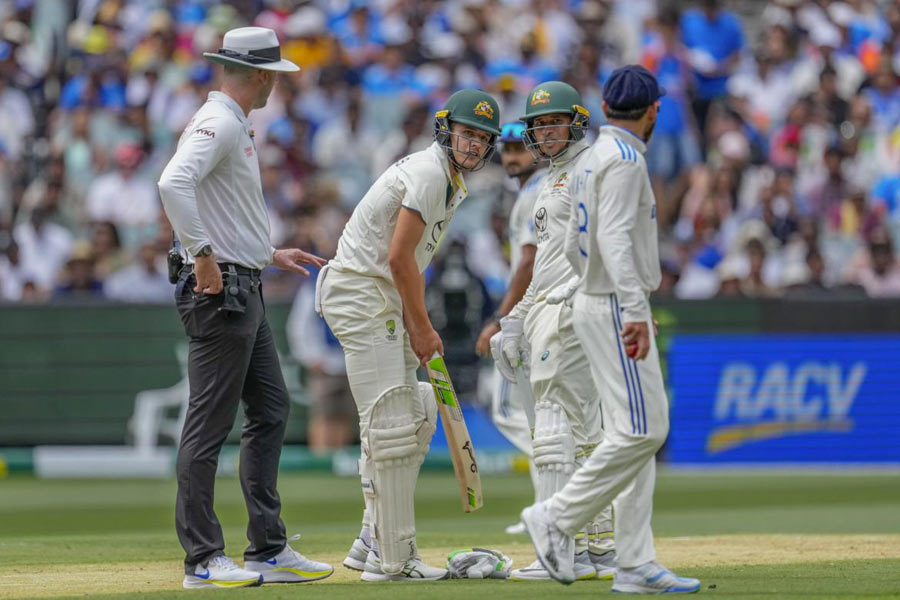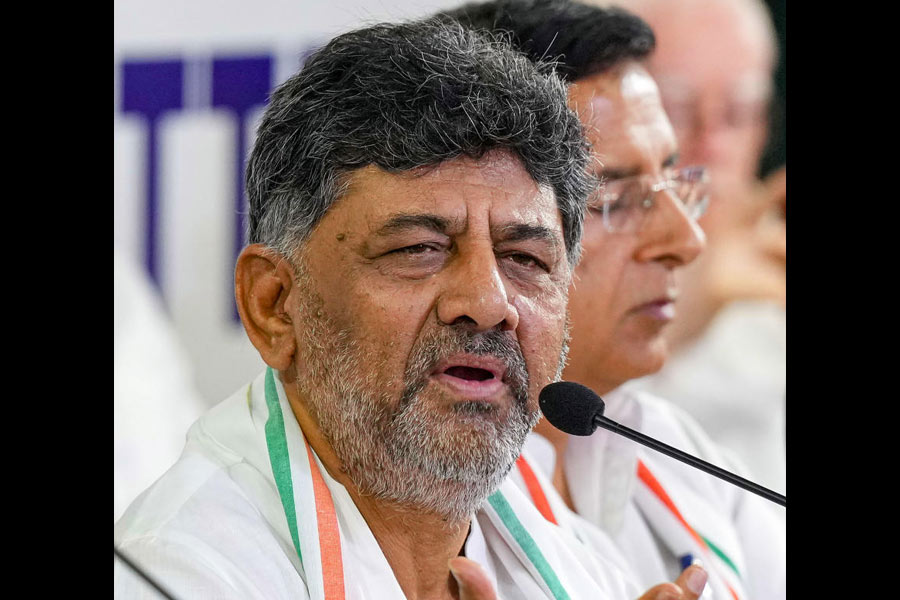However much it has evolved – and it has – the saree, at its core, remains traditional. As the Puja days culminate in a burst of colours and designs and fabrics, one can also see how this most elegant, unstitched piece of cloth retains its very features that have been experimented with, colours, designs and fabrics, even as it has recreated itself by taking on new features. (There is a lot to be learned from the sari.)
Long before the recent, intensive experimentation with the saree, especially the handloom saree, began, a landmark Calcutta store had started it. Established on August 15, 1974, Ananda aimed at reviving handloom saris of Bengal, with an emphasis on novelty in designs, colours, and most important, on quality. Master weavers were engaged in Phulia, the seat of the Bengali saree, and in Dhaniakhali, to recreate old styles in new fabrics. The weavers were provided with new yarns and designs. As they worked at their looms, the trademark “Ananda Tangail” was born.
Soon after came the block- and screen-printed silks. “Kalka”, “Scroll” and “Bobby Dots” meant something special for the women of Calcutta, as did the hand-embroidered Ananda panjabis and dhotis for the gentlemen.
From the beginning, Ananda has worked closely with the weaver families of Benares. Ananda’s designers have worked with them on each aspect of saree-making: patterns, colour palettes, thread counts, yarns and zari.
Such close collaboration with the master weavers over decades had resulted in “gems” that the boutique is proud of: 'keri', 'bael buti', 'kinkhaab', 'konia', 'jamdaani', 'shikargah', 'leheriya' or 'kadhwa'. Ananda boasts of these styles in a range of fabrics, such as katan silk, crepe silk, tussar, kora and cotton.
Master weavers from other parts of the country, such as Andhra Pradesh and Tamil Nadu, have also worked with Ananda to create masterpieces: cottons, silks, crepe de chines, Kanjivarams, Ikkats.
Each saree is a story, into which have been woven the work, the lives and the imagination of generations of a master weaver’s family.
Here, the models are wearing six of Ananda’s designs. We thought of suggesting to the readers a saree code for the Pujas.
However much it has evolved – and it has – the saree, at its core, remains traditional. As the Puja days culminate in a burst of colours and designs and fabrics, one can also see how this most elegant, unstitched piece of cloth retains its very features that have been experimented with, colours, designs and fabrics, even as it has recreated itself by taking on new features. (There is a lot to be learned from the sari.)
Long before the recent, intensive experimentation with the saree, especially the handloom saree, began, a landmark Calcutta store had started it. Established on August 15, 1974, Ananda aimed at reviving handloom saris of Bengal, with an emphasis on novelty in designs, colours, and most important, on quality. Master weavers were engaged in Phulia, the seat of the Bengali saree, and in Dhaniakhali, to recreate old styles in new fabrics. The weavers were provided with new yarns and designs. As they worked at their looms, the trademark “Ananda Tangail” was born.
Soon after came the block- and screen-printed silks. “Kalka”, “Scroll” and “Bobby Dots” meant something special for the women of Calcutta, as did the hand-embroidered Ananda panjabis and dhotis for the gentlemen.
From the beginning, Ananda has worked closely with the weaver families of Benares. Ananda’s designers have worked with them on each aspect of saree-making: patterns, colour palettes, thread counts, yarns and zari.
Such close collaboration with the master weavers over decades had resulted in “gems” that the boutique is proud of: 'keri', 'bael buti', 'kinkhaab', 'konia', 'jamdaani', 'shikargah', 'leheriya' or 'kadhwa'. Ananda boasts of these styles in a range of fabrics, such as katan silk, crepe silk, tussar, kora and cotton.
Master weavers from other parts of the country, such as Andhra Pradesh and Tamil Nadu, have also worked with Ananda to create masterpieces: cottons, silks, crepe de chines, Kanjivarams, Ikkats.
Each saree is a story, into which have been woven the work, the lives and the imagination of generations of a master weaver’s family.
Here, the models are wearing six of Ananda’s designs. We thought of suggesting to the readers a saree code for the Pujas.
However much it has evolved – and it has – the saree, at its core, remains traditional. As the Puja days culminate in a burst of colours and designs and fabrics, one can also see how this most elegant, unstitched piece of cloth retains its very features that have been experimented with, colours, designs and fabrics, even as it has recreated itself by taking on new features. (There is a lot to be learned from the sari.)
Long before the recent, intensive experimentation with the saree, especially the handloom saree, began, a landmark Calcutta store had started it. Established on August 15, 1974, Ananda aimed at reviving handloom saris of Bengal, with an emphasis on novelty in designs, colours, and most important, on quality. Master weavers were engaged in Phulia, the seat of the Bengali saree, and in Dhaniakhali, to recreate old styles in new fabrics. The weavers were provided with new yarns and designs. As they worked at their looms, the trademark “Ananda Tangail” was born.
Soon after came the block- and screen-printed silks. “Kalka”, “Scroll” and “Bobby Dots” meant something special for the women of Calcutta, as did the hand-embroidered Ananda panjabis and dhotis for the gentlemen.
From the beginning, Ananda has worked closely with the weaver families of Benares. Ananda’s designers have worked with them on each aspect of saree-making: patterns, colour palettes, thread counts, yarns and zari.
Such close collaboration with the master weavers over decades had resulted in “gems” that the boutique is proud of: 'keri', 'bael buti', 'kinkhaab', 'konia', 'jamdaani', 'shikargah', 'leheriya' or 'kadhwa'. Ananda boasts of these styles in a range of fabrics, such as katan silk, crepe silk, tussar, kora and cotton.
Master weavers from other parts of the country, such as Andhra Pradesh and Tamil Nadu, have also worked with Ananda to create masterpieces: cottons, silks, crepe de chines, Kanjivarams, Ikkats.
Each saree is a story, into which have been woven the work, the lives and the imagination of generations of a master weaver’s family.
Here, the models are wearing six of Ananda’s designs. We thought of suggesting to the readers a saree code for the Pujas.
However much it has evolved – and it has – the saree, at its core, remains traditional. As the Puja days culminate in a burst of colours and designs and fabrics, one can also see how this most elegant, unstitched piece of cloth retains its very features that have been experimented with, colours, designs and fabrics, even as it has recreated itself by taking on new features. (There is a lot to be learned from the sari.)
Long before the recent, intensive experimentation with the saree, especially the handloom saree, began, a landmark Calcutta store had started it. Established on August 15, 1974, Ananda aimed at reviving handloom saris of Bengal, with an emphasis on novelty in designs, colours, and most important, on quality. Master weavers were engaged in Phulia, the seat of the Bengali saree, and in Dhaniakhali, to recreate old styles in new fabrics. The weavers were provided with new yarns and designs. As they worked at their looms, the trademark “Ananda Tangail” was born.
Soon after came the block- and screen-printed silks. “Kalka”, “Scroll” and “Bobby Dots” meant something special for the women of Calcutta, as did the hand-embroidered Ananda panjabis and dhotis for the gentlemen.
From the beginning, Ananda has worked closely with the weaver families of Benares. Ananda’s designers have worked with them on each aspect of saree-making: patterns, colour palettes, thread counts, yarns and zari.
Such close collaboration with the master weavers over decades had resulted in “gems” that the boutique is proud of: 'keri', 'bael buti', 'kinkhaab', 'konia', 'jamdaani', 'shikargah', 'leheriya' or 'kadhwa'. Ananda boasts of these styles in a range of fabrics, such as katan silk, crepe silk, tussar, kora and cotton.
Master weavers from other parts of the country, such as Andhra Pradesh and Tamil Nadu, have also worked with Ananda to create masterpieces: cottons, silks, crepe de chines, Kanjivarams, Ikkats.
Each saree is a story, into which have been woven the work, the lives and the imagination of generations of a master weaver’s family.
Here, the models are wearing six of Ananda’s designs. We thought of suggesting to the readers a saree code for the Pujas.
However much it has evolved – and it has – the saree, at its core, remains traditional. As the Puja days culminate in a burst of colours and designs and fabrics, one can also see how this most elegant, unstitched piece of cloth retains its very features that have been experimented with, colours, designs and fabrics, even as it has recreated itself by taking on new features. (There is a lot to be learned from the sari.)
Long before the recent, intensive experimentation with the saree, especially the handloom saree, began, a landmark Calcutta store had started it. Established on August 15, 1974, Ananda aimed at reviving handloom saris of Bengal, with an emphasis on novelty in designs, colours, and most important, on quality. Master weavers were engaged in Phulia, the seat of the Bengali saree, and in Dhaniakhali, to recreate old styles in new fabrics. The weavers were provided with new yarns and designs. As they worked at their looms, the trademark “Ananda Tangail” was born.
Soon after came the block- and screen-printed silks. “Kalka”, “Scroll” and “Bobby Dots” meant something special for the women of Calcutta, as did the hand-embroidered Ananda panjabis and dhotis for the gentlemen.
From the beginning, Ananda has worked closely with the weaver families of Benares. Ananda’s designers have worked with them on each aspect of saree-making: patterns, colour palettes, thread counts, yarns and zari.
Such close collaboration with the master weavers over decades had resulted in “gems” that the boutique is proud of: 'keri', 'bael buti', 'kinkhaab', 'konia', 'jamdaani', 'shikargah', 'leheriya' or 'kadhwa'. Ananda boasts of these styles in a range of fabrics, such as katan silk, crepe silk, tussar, kora and cotton.
Master weavers from other parts of the country, such as Andhra Pradesh and Tamil Nadu, have also worked with Ananda to create masterpieces: cottons, silks, crepe de chines, Kanjivarams, Ikkats.
Each saree is a story, into which have been woven the work, the lives and the imagination of generations of a master weaver’s family.
Here, the models are wearing six of Ananda’s designs. We thought of suggesting to the readers a saree code for the Pujas.
However much it has evolved – and it has – the saree, at its core, remains traditional. As the Puja days culminate in a burst of colours and designs and fabrics, one can also see how this most elegant, unstitched piece of cloth retains its very features that have been experimented with, colours, designs and fabrics, even as it has recreated itself by taking on new features. (There is a lot to be learned from the sari.)
Long before the recent, intensive experimentation with the saree, especially the handloom saree, began, a landmark Calcutta store had started it. Established on August 15, 1974, Ananda aimed at reviving handloom saris of Bengal, with an emphasis on novelty in designs, colours, and most important, on quality. Master weavers were engaged in Phulia, the seat of the Bengali saree, and in Dhaniakhali, to recreate old styles in new fabrics. The weavers were provided with new yarns and designs. As they worked at their looms, the trademark “Ananda Tangail” was born.
Soon after came the block- and screen-printed silks. “Kalka”, “Scroll” and “Bobby Dots” meant something special for the women of Calcutta, as did the hand-embroidered Ananda panjabis and dhotis for the gentlemen.
From the beginning, Ananda has worked closely with the weaver families of Benares. Ananda’s designers have worked with them on each aspect of saree-making: patterns, colour palettes, thread counts, yarns and zari.
Such close collaboration with the master weavers over decades had resulted in “gems” that the boutique is proud of: 'keri', 'bael buti', 'kinkhaab', 'konia', 'jamdaani', 'shikargah', 'leheriya' or 'kadhwa'. Ananda boasts of these styles in a range of fabrics, such as katan silk, crepe silk, tussar, kora and cotton.
Master weavers from other parts of the country, such as Andhra Pradesh and Tamil Nadu, have also worked with Ananda to create masterpieces: cottons, silks, crepe de chines, Kanjivarams, Ikkats.
Each saree is a story, into which have been woven the work, the lives and the imagination of generations of a master weaver’s family.
Here, the models are wearing six of Ananda’s designs. We thought of suggesting to the readers a saree code for the Pujas.
Make-up expert Subhash Shinde, with looks of films such as Sarbjit, Mary Kom, Ram-Leela and Black on his CV, had a kitty-ful of tips and tricks for a roomful of make-up enthusiasts. They gathered at Vogue Up, a fashion and make-up academy at P23, Calcutta, for a workshop, in association with t2. We caught up with Shinde for a tete-e-tete.
Make-up expert Subhash Shinde, with looks of films such as Sarbjit, Mary Kom, Ram-Leela and Black on his CV, had a kitty-ful of tips and tricks for a roomful of make-up enthusiasts. They gathered at Vogue Up, a fashion and make-up academy at P23, Calcutta, for a workshop, in association with t2. We caught up with Shinde for a tete-e-tete.
Make-up expert Subhash Shinde, with looks of films such as Sarbjit, Mary Kom, Ram-Leela and Black on his CV, had a kitty-ful of tips and tricks for a roomful of make-up enthusiasts. They gathered at Vogue Up, a fashion and make-up academy at P23, Calcutta, for a workshop, in association with t2. We caught up with Shinde for a tete-e-tete.
Beauty basics
- Apply moisturiser an hour before applying make-up.
- Apply foundation or compact on your neck too, to avoid the patchy look.
- Blush-on should be applied on the cheekbones to make the face look thin.
- Water acts as a lock when sprayed on make-up and prevents it from becoming cake-y and also lessens the intensity of chemicals.
- Start applying the lip liner and the lipstick from the ‘v’ of the lips.
- Always start with under eyes.
- Mascara should be applied on both the upper and lower lashes.
- To intensify the eyebrows, one must use dark brown shadow with an eyebrow brush.
- The T-zone, that is the bridge of the nose, should always be one tone brighter than your skin colour.
- Eyeshadow should be applied from the corner of the eye and go from dark to light.











